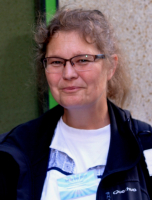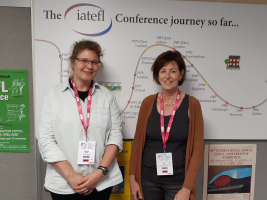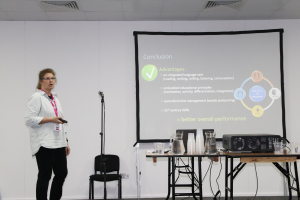- Home
- Grants and PDA Fund
- Professional Development Aid Fund (PDA)
- 2017 Winner Belgian Presenter IATEFLTravel Grant
2017 Winner Belgian Presenter IATEFLTravel Grant
Natascha Coene
2017 Belgian IATEFL Presenter Travel Grant Winner
The first winner of THE BELGIAN IATEFL PRESENTER TRAVEL GRANT was Natascha Coene. Although Natascha had attended the IATEFL 2017 Glasgow Conference, the IATEFL 2018 Brighton Conference would be her first time presenting at this international event. In addition to delivering a stellar session, Natascha also won a prize from National Geographic for her photography!
Here is a summary of her presentation, which she also shared with our members at BELTA Day 2018!
Three types of presentations used to write a reading portfolio
Natascha Coene
Students have to produce numerous presentations. Most stick to PowerPoint or Prezi. One of my frustrations as a teacher was - and sometimes still is - that the audience picks up very little from what is said. At times the presentations are indeed boring and just a show of a few slides, but very often interesting topics are dealt with. In certain cases these presentations can be made more attractive by using alternative presentations that thanks to their particular characteristics serve specific aims better.
My presentation based on my lessons wants to show through a practical example how alternative ways of presentations (elevator pitch, poster presentation, Pecha Kucha) can efficiently support the writing of a reading portfolio, in addition turning it into an integrated skills activity.
Sixth formers at my school, option modern languages, have to write a reading portfolio in which they compare two books on the basis of a chosen topic. Before they carry their research into effect they have to formulate a research question. The students are given eight months to complete this task. To make sure that they don’t postpone everything until the end, they have to report at regular intervals. The whole process is made more efficient by asking students to give specific presentations dealing with certain aspects in the course of the writing process:
The initial ideas and the research question are communicated orally to the other students by using an elevator pitch. This forms the basis for a short written report.
The books, the research question, the method and the (expected) results are exhibited by using a poster presentation.
The final result is presented in a Pecha Kucha presentation.
These alternative ways of presentation are helpful because they require the students to think about the structure of their work and it helps them to go deeper into the content.
Reading, writing, speaking and to a lesser extent listening skills combine into an integrated language task that could also be used by other secondary school teachers.
This practical example features within the need to invest in 21stcentury learning. The initial frustration emanated largely from presentations during European projects. This triggered off the idea to start a project focussing on presentations. In itself this proved to be too thin to build a whole project around, but it will be part of our next project, if at least it is approved. The four C’s of 21stlearning skills can be applied to different forms of presentations. In order to decide what to put into their presentation and what kind of presentation to choose, students have to appeal to the skill of critical thinking. Presentations are a form of communication. Students will achieve a better result if they use their creativity. Through peer evaluation and making students discuss the results of their presentations they are also given the chance to collaborate.
Presentations are definitely a tool for language teaching in the 21stcentury!



